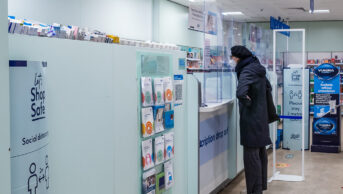
Shutterstock.com
There has been a significant increase in the number of overseas pharmacists who wish to work in Great Britain, helping to plug workforce gaps.
Data provided to The Pharmaceutical Journal by the General Pharmaceutical Council (GPhC) show there have been 725 applications to the Overseas Pharmacists Assessment Programme (OSPAP) in the nine months between 1 March and 8 December 2022.
In the 12 months from March 2021 to March 2022, there were 599 applications for the programme.
Interest in the programme has continued to grow over the past few years: there were 151 applications between March 2020 and March 2021, and 78 applications between March 2019 and March 2020.
Pharmacists were added to the Home Office’s shortage occupation list in March 2021, following a recommendation by the Migration Advisory Committee, which makes it easier for internationally-qualified pharmacists to successfully apply for a skilled worker visa through the UK’s immigration system.
Completion of the OSPAP programme is a requirement for internationally-qualified pharmacists from outside the European Economic Area (EEA) who want to join the GPhC register, or for those holding an EEA pharmacy qualification that would not otherwise allow them to join the register.
Pharmacists from EEA nations with relevant European qualifications — listed in directive 2005/36/EC of the European Parliament and of the Council — can still apply to register with the GPhC for up to two years and do not need to go through the OSPAP programme.
The GPhC figures show that 522 of the 725 applications received since 1 March 2022 have been approved. The total number of applications approved since March 2022 is 616, but this includes some applications received before that date.
Claire Anderson, president of the RPS, said it was “fantastic” that the programme was increasing in popularity.
“We want to make it easier for overseas pharmacists to come and work here.
“This includes overcoming barriers with visas, limited university places to complete training and the associated costs. However, this is not a quick fix and what is really needed is a comprehensive workforce plan for pharmacy, in line with other healthcare professions, to provide certainty about the recruitment, training and retention of the pharmacy workforce.”
In January 2022, Health Education England’s Community Pharmacy Workforce Survey revealed that 8% of all full-time equivalent pharmacist posts were vacant in 2021.
Meanwhile, in The Pharmaceutical Journal’s 2021 salary survey, nearly three-quarters (73%) of pharmacists selected ‘staff absence’ as a reason for stress at work. And the Pharmacists’ Defence Association’s ‘2021 Safer Pharmacies Survey‘ found that just 2.6% of pharmacists said that their place of work always has safe staffing levels.
1 comment
You must be logged in to post a comment.



Great article! However, increased adjudication is not met up with increased seats for OSPAP in the universities, resulting into too many students not getting admission and wasting time and money. To put things into perspective, only about 200 applicants could secure a seat in 4 different universities for the year 2023. This will create a backlog of about 500 applicants, with addition to, I think, 700 more applicants for the next year (2024). But the number of OSPAP -offering universities and the number of seats will remain the same.